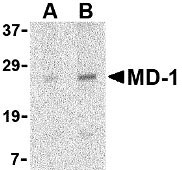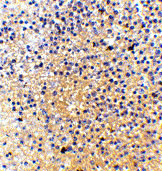MD-1 Antibody
- 产品详情
- 实验流程
- 背景知识
Application
| WB, E, IHC-P |
|---|---|
| Primary Accession | O95711 |
| Other Accession | NP_004262, 4758708 |
| Reactivity | Human, Mouse, Rat |
| Host | Rabbit |
| Clonality | Polyclonal |
| Isotype | IgG |
| Calculated MW | 17906 Da |
| Concentration (mg/ml) | 1 mg/mL |
| Conjugate | Unconjugated |
| Application Notes | MD-1 antibody can be used for the detection of MD-1 by Western blot at 1 - 2 µg/mL. Antibody can also be used for immunohistochemistry starting at 2.5 µg/mL. |
| Gene ID | 9450 |
|---|---|
| Other Names | MD-1 Antibody: MD-1, MMD-1, dJ80N2.1, MD1, Lymphocyte antigen 86, Protein MD-1, Ly-86, lymphocyte antigen 86 |
| Target/Specificity | LY86; |
| Reconstitution & Storage | MD-1 antibody can be stored at 4℃ for three months and -20℃, stable for up to one year. As with all antibodies care should be taken to avoid repeated freeze thaw cycles. Antibodies should not be exposed to prolonged high temperatures. |
| Precautions | MD-1 Antibody is for research use only and not for use in diagnostic or therapeutic procedures. |
| Name | LY86 |
|---|---|
| Synonyms | MD1 |
| Function | May cooperate with CD180 and TLR4 to mediate the innate immune response to bacterial lipopolysaccharide (LPS) and cytokine production. Important for efficient CD180 cell surface expression (By similarity). |
| Cellular Location | Secreted, extracellular space. Note=Associated with CD180 at the cell surface |
| Tissue Location | Highly expressed in B-cells, monocytes and tonsil. |
For Research Use Only. Not For Use In Diagnostic Procedures.
Provided below are standard protocols that you may find useful for product applications.
BACKGROUND
MD-1 Antibody: Toll-like receptors (TLRs) are evolutionarily conserved pattern-recognition molecules that recognize different microbial products during infection and serve as an important link between the innate and adaptive immune responses. The signaling of these TLRs is kept under tight control by the expression of endogenous inhibiting proteins such as RP105, a recently identified homolog of TLR4. This protein, in association with MD-1, interacts with and inhibits the TLR4/MD-2 signaling pathway. While MD-2 can directly bind to LPS, one of the activating molecules of TLR4, the function of MD-1 is less well-known. It has been suggested however, that the RP105/MD-1 complex influences antibody production mediated by both TLR4/MD-2 and TLR2 receptor complexes.
REFERENCES
Takeda K, Kaisho T, and Akira S. Toll-like receptors. Annu. Rev. Immunol. 2003; 21:335-76.
Divanovic S, Trompette A, Atabani SF, et al. Inhibition of TLR-4/MD-2 signaling by RP105/MD-1. J. Endotoxin Res. 2005; 11:363-8.
Tsuneyoshi N, Fukudome K, Kohara J, et al. The functional and structural properties of MD-2 required for liposaccharide binding are absent in MD-1. J. Immunol. 2005; 174:340-4.
Nagai Y, Kobayashi T, Motoi Y, et al. The radioprotective 105/MD-1 complex links TLR2 and TLR4/MD-2 in antibody response to microbial membranes. J. Immunol. 2005; 174:7043-9.
终于等到您。ABCEPTA(百远生物)抗体产品。
点击下方“我要评价 ”按钮提交您的反馈信息,您的反馈和评价是我们最宝贵的财富之一,
我们将在1-3个工作日内处理您的反馈信息。
如有疑问,联系:0512-88856768 tech-china@abcepta.com.























 癌症的基本特征包括细胞增殖、血管生成、迁移、凋亡逃避机制和细胞永生等。找到癌症发生过程中这些通路的关键标记物和对应的抗体用于检测至关重要。
癌症的基本特征包括细胞增殖、血管生成、迁移、凋亡逃避机制和细胞永生等。找到癌症发生过程中这些通路的关键标记物和对应的抗体用于检测至关重要。 为您推荐一个泛素化位点预测神器——泛素化分析工具,可以为您的蛋白的泛素化位点作出预测和评分。
为您推荐一个泛素化位点预测神器——泛素化分析工具,可以为您的蛋白的泛素化位点作出预测和评分。 细胞自噬受体图形绘图工具为你的蛋白的细胞受体结合位点作出预测和评分,识别结合到自噬通路中的蛋白是非常重要的,便于让我们理解自噬在正常生理、病理过程中的作用,如发育、细胞分化、神经退化性疾病、压力条件下、感染和癌症。
细胞自噬受体图形绘图工具为你的蛋白的细胞受体结合位点作出预测和评分,识别结合到自噬通路中的蛋白是非常重要的,便于让我们理解自噬在正常生理、病理过程中的作用,如发育、细胞分化、神经退化性疾病、压力条件下、感染和癌症。







